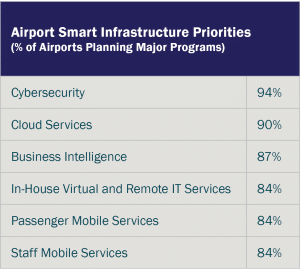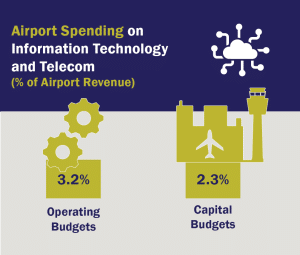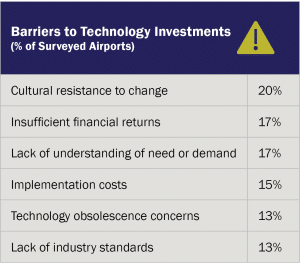How Airports Can Build Smart from the Start
Evolving mobile and digital technologies present tremendous opportunities to transform the airport experience.
While most airports acknowledge the promise offered by the latest technology developments, many continue to struggle advancing digital transformation initiatives beyond pilot projects.
Successfully incorporating new technologies into terminal development projects requires capital investment, careful long-term planning, and a shift away from approaches that treat technology upgrades as siloed systems.
Rather than build new capacity without the intelligence — and plan to add the “brains” later — airport visionaries are recognizing the benefit of terminal facilities that are smart and adaptive from the very start.
Harnessing Smart Infrastructure
Airports are hungry for innovation. And yet, airports typically struggle to advance their innovation goals.
Historically, the fault lies in a combination of complicated procurement mechanisms, reluctance to partner with inexperienced technology startups, and a general hesitancy to take risks with innovative technologies in high-visibility, capital-intensive projects. Some airport leaders have also expressed concerns that today’s frontier technology will be outdated when a terminal opens years after initial planning.
As a result, nascent technologies often become attractive candidates for cost reduction — especially when they lack a physical dimension. Investments in software-based technology, Internet of Things (IoT) sensors, and data-analysis tools frequently become treated as non-essential to construction.
Equally problematic, construction schedules frequently do not take into account technology installation considerations. Special systems design teams are often not engaged until after major infrastructure decisions are already made.
Five Key Elements to Achieve Smart Infrastructure Goals

Source: SITA/Airport Council International 2020 Airport IT Trends Survey
Technology development occurs in months, often with higher upfront costs. Airport development takes years, involving finite capital funds, and projects must satisfy public agencies usually with limited appetite for risk.
How, then, should airport operators, designers and builders achieve their goals of smart infrastructure? The strategy rests on five foundational elements.
Owner Committed to Advanced Technology Facilities
Building state-of-the-art, technologically smart facilities requires focusing decision-making on a goal that embraces the digital world as well as the physical one. Success often involves efforts to unite stakeholders and community leaders around a shared commitment to create truly remarkable and memorable facilities.
In fact, most leaders are eager to make public investments in advanced technology when given the choice. In some cases, they may prefer the business and operational benefits of innovation and technology over purely physical accoutrements.
State-of-the-art, technologically smart facilities embrace the digital world as well as the physical one. | Courtesy of British Airways
Development of innovation strategies can be useful exercises to align expectations and to raise awareness of technology benefits among internal and external stakeholders. A well-articulated strategy can facilitate a shift toward an organizational mindset that is more creative and technologically progressive.
Projects Budgeted Correctly
Capital projects invariably face budget pressure. Given the pressure that face many airport capital projects in particular, allocating additional resources to smart infrastructure can often be a challenge.
Accurate budgets can help to reduce uncertainty and encourage adoption. Although digital technology costs are constantly evolving, experienced forecasters can accurately estimate smart infrastructure costs and adjust budgets as the market for new technologies advance.
Unfortunately, smart infrastructure costs are consistently undervalued. A common lament is that “it just can’t cost that much,” with a resultant reduction in the technology line item. Wishful thinking becomes manifest much later, when it does cost that much.

Source: SITA/Airport Council International 2020 Airport IT Trends Survey
Limiting the budget by setting arbitrary cost ceilings or insufficient “technology allowances” adds further complications. By itself, cost ceilings are a practical and necessary boundary condition for all projects. If, however, the ceiling prevents true costs from being exposed, debated and resolved, it becomes another cost gremlin that commonly appears later.
Whatever the circumstances that influence project budgets, it is helpful to maintain an objective, informed view of technology and innovation project costs early in the project’s development. Costs may need to be reconciled with overall cost constraints and the evolving nature of technology developments. Still, airports are more likely to retain innovation components as cost pressures mount if the project is budgeted accurately.
Projects Scheduled Astutely
In the airport technology business, it is widely accepted that our contractors are the last trade in and the last one out. That axiom needs a refresh.
Traditional approaches to technology infrastructure wait until after communications equipment rooms are constructed before engaging low-voltage systems contractors. Yet modern terminals may require 50 technology systems and applications, with multiple innovation projects transpiring simultaneously.
Later involvement of special-systems teams will inevitably cause delays. Integrating technology contractors earlier in the process can help ensure sufficient time is allotted in the project schedules for digital systems to be installed, integrated, tested and commissioned. Project managers therefore need to have an overall knowledge of the IT scope and timelines to build a realistic construction schedule.
Development Team Integrated
To foster innovation, it is becoming increasingly common for airports to physically segregate employees working on digital transformation projects. An “airport innovation lab” can be an effective approach to encourage creative infrastructure strategies. But once a terminal design and construction program begins, the oppositive approach is needed.

Source: Arthur D Little
Airports encourage and sometimes demand that the design and construction team co-locate on site. This Project Management Office (PMO) model can facilitate collaboration. However, it often remains uncommon for technology leaders to be brought into this environment.
Integrating the Chief Information Officer, Chief Technology Officer, or other technology leaders with the construction team can enable greater coordination and focus.
Integrated teams can be found at projects taking place across Orlando International Airport, Dallas-Ft Worth International Airport, and Los Angeles International Airport, for example. In these instances, the CIO or CTO, as well as their innovation teams, are intertwined in capital projects from the outset.
Focus on End-User Experience
Despite significant investment in new and innovative technologies, adoption can sometimes be disappointing. Airport staff may receive limited training, leaving them uncertain of the technology’s benefits. Non-visual user instructions such as a simple QR code can create additional barriers, limiting staff and passengers’ interests in making best use of the new technologies.
Low usage of many functionalities not only limits the project’s benefits. Without focus on the end-user experience, project designers may undermine the appetite for future digital transformation projects if the public does not understand its value.
“The most technologically progressive airports are poised to become the travel hub of choice for increasingly connected and discerning passengers.”
Cost of Technology Inaction
Airports mired in innovation inaction will inevitably lose ground with more tech-savvy competitors.
Yet smart infrastructure not only creates a strategic differentiation. Adoption of smart digital technologies can also generate new sources of revenue, enhance operational performance across the airport campus, elevate passenger experiences, and strengthen security systems.
Despite the benefits, many airport leaders opt to build new capacity without the intelligence. But smart infrastructure does not have to be dumb initially, with an IQ increase later on.
Efforts to de-silo technology from design and construction, with special attention to technology costs during the budget and scheduling process, can increase opportunities for integrating new technologies into longer-term terminal development.
Photography courtesy of British Airways.


